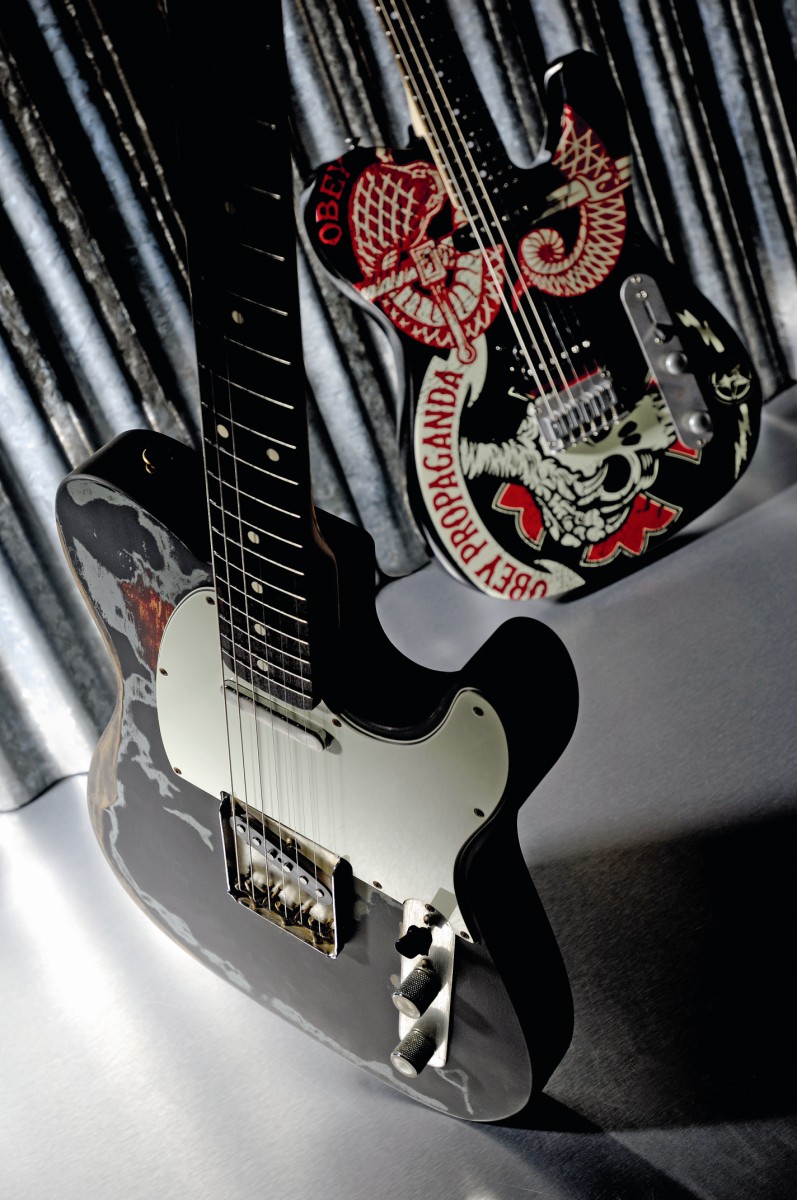MusicRadar Verdict
An excellent first guitar for any player with an eye for the unusual.
Pros
- +
Great neck. Cool graphics. Plays superbly.
Cons
- -
Clunky hardware.
MusicRadar's got your back
Of the current members of Squire's Obey Graphic Series, it's this example that offers a design not found elsewhere within the roster.
The remainder of the range, another Tele and a Strat, both bear homage to Fairey's work via a collage of sorts that's busier than the Propaganda artwork shown here.
The graphic itself is applied via a simple decal placed on top of the wholly black agathis slab body and lends itself perfectly to the intended overall picture.
The industrial, left-field vibe is further added to by the provision of Squier's RusticAndWorn (sic) hardware that includes the six tuners.
Okay, so the engraved neck plate bears a swathe of faux rust but the remaining items - the knobs, control plate, bridge and machines - resemble less pieces that have been lovingly aged, akin to the majority of the Custom Shop canon, and more thick pieces of metal that have been found kicking around a car park.
Still, all operate perfectly acceptably, even though we can't help wondering just what black hardware would have looked like here.
To prove yet again that the humble Tele can rock as hard as any reverse-headstocked apparition, pickups here comprise the increasingly popular Duncan Designed HB102B humbucker at the bridge and a Strat-sized Alnico single-coil at the neck.
We initially perceived that a matching graphic headstock could well have been a suitable addition to the design but we're not complaining.
Here, complete with skunk stripe, the guitar punches way above its modest price tag with a lovely silky feel to the back of the neck and a quality set-up to the proud mediumjumbo frets.
To be fair, it's only the cheap 'n' cheerful white plastic nut that gives the game away that this isn't a considerably more expensive instrument: long may Squier continue to offer such excellent necks.
Sounds
There's nothing about the Tele's classic single-cut design that stops it being the consummate tool for rock and, with the DD humbucker switched in, there's definition, depth and body to even the hottest of crunching rhythm tones.
Thanks to the low action, plus an excess of treble bite the further up the neck you go, it's very good for soloing purposes too.
Fret access isn't even an issue and, for all your rock tricks, the Tele keeps up with you, helping you play rather than ever hindering.
If you feel you'd miss that classic Tele zing when John 5 ersatz-country styles are in order, the central selection on the three-way, that combines both pickups in their entirety, will come as a pleasant surprise.
With a modicum of drive it's brash and aggressive and, when your amp is set appropriately, could pass for a Rickenbacker for those classic Weller chords.
We found the neck pickup was set a little too low into the body for our tastes but, after a few turns on the mounting screws, it offers slightly thinner yet effortlessly useable versions of those familiar Stratocaster neck tones.
As it has a fantastic neck and worn parts, as well as the eye-popping graphics and several cool tones, the price of £269 makes the buying decision very straightforward: if you like the look of it, buy it - you won't be disappointed.
It's a great time to be into the humble Telecaster and, if this is anything to go buy, we can't wait to see what Fender comes up with next.
Simon Bradley is a guitar and especially rock guitar expert who worked for Guitarist magazine and has in the past contributed to world-leading music and guitar titles like MusicRadar (obviously), Guitarist, Guitar World and Louder. What he doesn't know about Brian May's playing and, especially, the Red Special, isn't worth knowing.
“I have an original 909 – every time I try to use it I feel like I’m ruining it”: House hero Riva Starr on his studio essentials and his love of analogue synths
“A synthesizer that is both easy to use and fun to play whilst maintaining a decent degree of programming depth and flexibility”: PWM Mantis review
“I feel like that song had everything we needed to come back with”: Bring Me The Horizon’s Lee Malia on Shadow Moses, its riff and the secrets behind its tone, and why it was the right anthem at the right time










